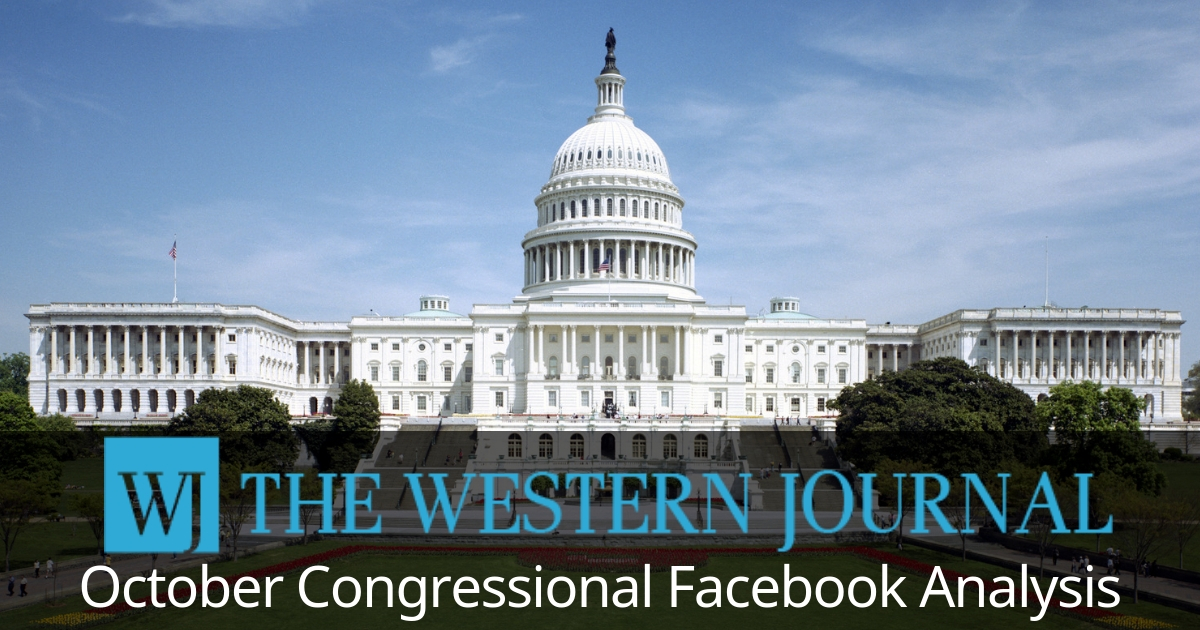
By the Numbers: Here's How Members of Congress Did on Facebook in October
Facebook pages associated with members of both major political parties have continued to fluctuate in the months following the social media giant’s major algorithm changes earlier in 2018, according to updated analysis by The Western Journal.
After Facebook implemented changes to its News Feed algorithm in January, The Western Journal confirmed that publishers, including public officials, had been significantly affected by the change.
According to ongoing analysis of more recent data, pages associated with members of both major political parties saw a significant decrease in interactions with readers following the change in January.
Analysis of data from the month of October showed that the interaction rate on Republican and Democratic congressional Facebook pages seems to be greatly influenced by people’s reactions to current events.
The Numbers
The Western Journal recently analyzed the interaction rates on congressional Facebook pages from October 2018.
For comparison, previous analysis had shown pages operated by Democratic politicians had an interaction rate of .89 during February through June, whereas pages owned by their Republican counterparts saw only a .41 interaction rate.
Speaking very generally, interaction rates for Democrat-run pages have fallen somewhat since then, while rates for Republicans have trended in the other direction. Also generally, Republican senators seem to have fared marginally better than their counterparts on the other side of the aisle, while Democratic House members continue to see slightly better interactions rates than Republicans.
During the first week of October (Oct. 1-6), Democratic pages had a 0.80 percent interaction rate, while there was a 1.50 percent interaction rate on Republican pages. In the second week of October (Oct. 7-13), there was a 0.52 percent interaction rate on Democratic pages and a 0.61 percent interaction rate on Republican pages. During the week of Oct. 14 – Oct. 20, Democratic pages had a 0.55 percent interaction rate compared to a 0.47 percent interaction rate on Republican pages. From Oct. 21 – Oct. 27, there was a 0.46 percent interaction rate on Democratic pages and a 0.57 percent interaction rate on Republican pages. During the last few days of October (Oct. 28 – Oct. 30), Democratic pages had a 0.45 percent interaction rate, while there was a 0.47 percent interaction rate on Republican pages.
The month of October was busy for politicians, with both Republican and Democratic senators and representatives gearing up for the midterm elections on Nov. 6. From debates and scandals to fundraising and advertising, each person running for re-election was focused on getting their constituents to reelect them. It is unsurprising, because of this, that interaction rates were higher this month.
In addition, numerous high-profile stories affected news cycles — and probably interaction rates — during the month.
At the beginning of October, social media users everywhere were buzzing about the possible confirmation of Brett Kavanaugh to the Supreme Court following sexual assault allegations against him. The Senate had the responsibility to decide whether or not to appoint the then-nominee, so it is not surprising to see higher interaction rates on both Republican and Democratic senators’ Facebook pages. The day after Kavanaugh’s confirmation on Oct. 6, there was a rapid decline in interaction rates on senators’ Facebook posts.
Hurricane Michael hit the Florida coast on Oct. 10 with maximum sustained winds of over 150 mph. The hurricane was responsible for at least 11 deaths and was the most powerful hurricane to hit the continental U.S. in over 50 years. Then, a few days after the hurricane hit, a caravan of migrants fleeing Honduras started moving northward with the goal of entering the United States, rekindling the immigration and border security debate.
A series of suspicious packages was sent to high-profile targets such as Barack Obama, Hillary Clinton, CNN and Cory Booker toward the end of the month. The violent actions were quickly condemned; however, people from both sides of the aisle started pointing fingers to who was indirectly responsible. President Donald Trump’s rhetoric, in particular, has been blamed for the violence — especially after the shooting at the Tree of Life Synagogue in Pittsburgh on Oct. 27.
At the very end of October, in an exclusive interview with Axios published on Oct. 30, Trump said he plans on ending birthright citizenship for those who were born in the U.S. from illegal or non-citizens. Speaker of the House Paul Ryan, the American Civil Liberties Union and Sen. John Hoeven were among the many who weighed in on Trump’s plan to sign an executive order to create this policy.
In the House of Representatives, there was a 0.51 percent interaction rate on Democratic pages and a 0.65 percent interaction rate on Republican pages during the week of Oct. 1 – Oct. 6. Interaction rates were a little lower during the week of Oct. 7 – Oct. 13. There was a 0.47 percent interaction rate on Democratic pages and a 0.52 percent interaction rate on Republican pages. There was a 0.38 percent interaction rate on Democratic pages and a 0.48 percent interaction rate on Republican pages during the week of Oct. 14 – Oct. 20. In the last full week of October (Oct. 21-27), Democratic pages had a 0.47 percent interaction rate compared to a 0.55 percent interaction rate on Republican pages. There was a 0.48 percent interaction rate on Democratic pages and a 0.55 percent interaction rate on Republican pages from Oct. 28 – Oct. 31.
In the Senate, there was a 1.08 percent interaction rate on Democratic pages and a 2.35 percent interaction rate on Republican pages during the week of Oct. 1 – Oct. 6. These high interaction rates can most likely be attributed to the Senate confirmation of Brett Kavanaugh and constituents interacting with their senators to give their opinion on what they should do. Interaction rates during the week of Oct. 7 – Oct. 13 fell to 0.56 percent on Democratic pages and 0.70 percent on Republican pages. There was a 0.72 percent interaction rate on Democratic pages and a 0.45 percent interaction rate on Republican pages during the week of Oct. 14 – Oct. 20. In the last full week of October (Oct. 21-27), Democratic pages had a 0.44 percent interaction rate compared to a 0.58 percent interaction rate on Republican pages. There was a 0.51 percent interaction rate on Democratic pages and a 0.39 percent interaction rate on Republican pages from Oct. 28 – Oct. 31.
Interaction rates are the average interactions (likes, shares or comments on a post) divided by the number of page followers for each page. Regardless of a change in the number of posts or followers, the interaction rate on a given Facebook page should remain similar from month to month, all else being equal.
Why This Matters
In January, Facebook CEO Mark Zuckerberg announced that the social media platform would be rolling out a new algorithm. This algorithm would prioritize “friends, family and groups” in users’ News Feeds and show fewer public content like posts from “businesses, brands, and media.” The decrease in interaction rates on these representatives’ pages indicates that some pages have indeed been targeted, intentionally or unintentionally, since this change was made.
This change continues to have serious implications for the near future.
According to a July analysis by The Western Journal, Facebook pages associated with members of Congress from both major parties saw a significant decrease in interactions with readers in the months immediately following that algorithm change. However, the Facebook pages of Republican members of the House and Senate were affected more than those of their Democrat counterparts.
This means that Americans who stay informed about their elected representatives by following the Facebook pages of their state’s senators and representatives are less likely to see posts from these pages — especially if they are Republicans or conservatives.
Additionally, if representatives are hindered in their ability to deliver their stance on issues to the people they represent, the public is less likely to know where they stand on the issues — leading to an uninformed public that could swing elections.
It could be argued that the closing of the gap in interaction rates between Republican and Democratic politicians follows a closing of the “enthusiasm gap” between Republican and Democratic voters, particularly in the wake of the Kavanaugh hearings.
Where the Data Comes From
To conduct this evaluation, The Western Journal pulled Facebook data from CrowdTangle for all current Congress members with an official Facebook page using CrowdTangle’s lists: U.S. House Democrats Official, U.S. Senate Democrats, U.S. House GOP Official and U.S. Senate GOP. However, the CrowdTangle lists were missing a few Congress members, so The Western Journal found those pages and added them to the lists. The data does not include Sens. Bernie Sanders and Angus King who are on the U.S. Senate Independents list. Sanders’ large following alone would greatly scew any data. The data was then aggregated for Facebook pages from October 2018.
The Western Journal also used CrowdTangle’s calculation of each chamber of Congress’ weekly interaction rate. Those weekly interaction rates were then combined by taking the average of the two to find the interaction rate for Republican and Democratic congressional Facebook pages.
This data measures users’ interactions with the posts and not the reach of the post. Reach data is available only to individual publishers and is not made public by Facebook. However, the interactions are good general indicators of reach because when more users see a given post, interactions with that post should rise accordingly.
The fact that Facebook only reveals a limited amount of data regarding public pages — and essentially no data at all about the algorithm used to show posts on users’ News Feeds — in turn limits the ability of users, journalists and others to analyze cause and effect.
Facebook’s significant lack of data transparency makes it impossible for The Western Journal, government regulators or anyone else to defend Facebook’s internal processes as unbiased, make a credible accusation of intentional bias, or make any sort of defensible statement in between.
Therefore, The Western Journal has analyzed the data available to us in this analysis as well as others.
For the rest of our Congressional Facebook Analyses, follow this link.
Truth and Accuracy
We are committed to truth and accuracy in all of our journalism. Read our editorial standards.
Advertise with The Western Journal and reach millions of highly engaged readers, while supporting our work. Advertise Today.












